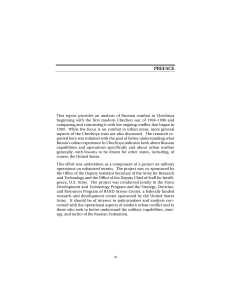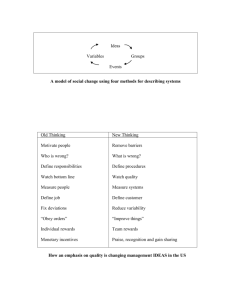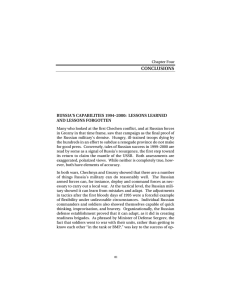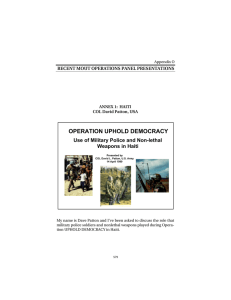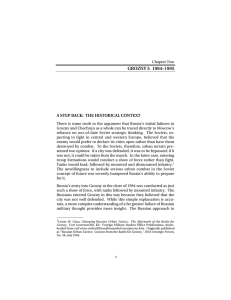SUMMARY
advertisement
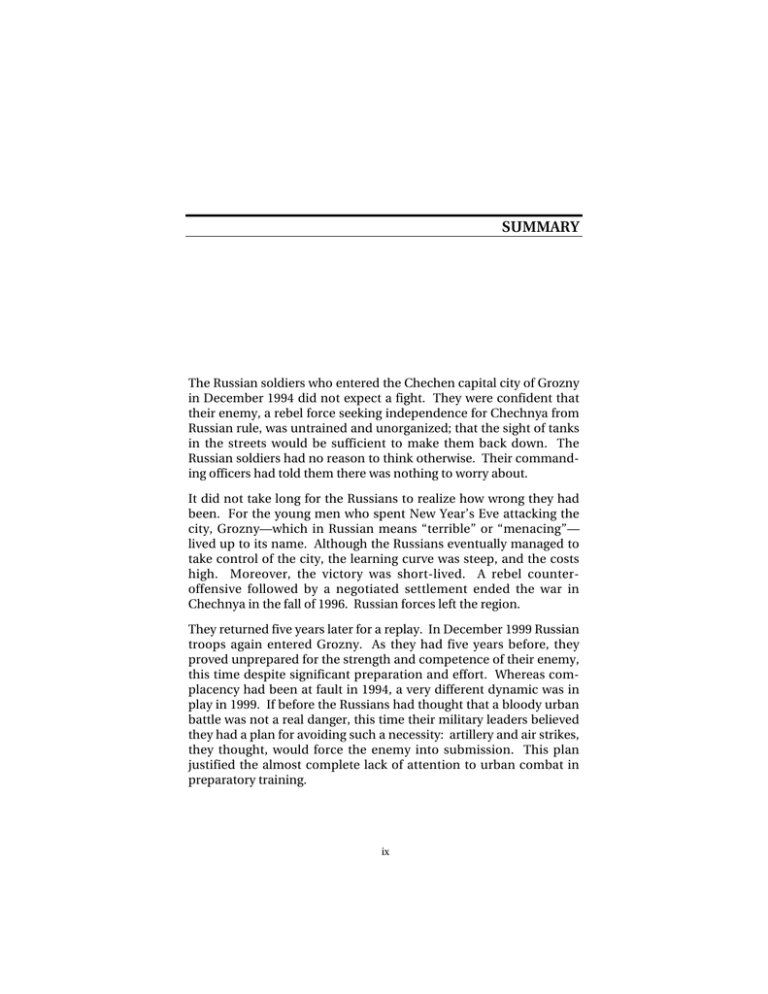
SUMMARY The Russian soldiers who entered the Chechen capital city of Grozny in December 1994 did not expect a fight. They were confident that their enemy, a rebel force seeking independence for Chechnya from Russian rule, was untrained and unorganized; that the sight of tanks in the streets would be sufficient to make them back down. The Russian soldiers had no reason to think otherwise. Their commanding officers had told them there was nothing to worry about. It did not take long for the Russians to realize how wrong they had been. For the young men who spent New Year’s Eve attacking the city, Grozny—which in Russian means “terrible” or “menacing”— lived up to its name. Although the Russians eventually managed to take control of the city, the learning curve was steep, and the costs high. Moreover, the victory was short-lived. A rebel counteroffensive followed by a negotiated settlement ended the war in Chechnya in the fall of 1996. Russian forces left the region. They returned five years later for a replay. In December 1999 Russian troops again entered Grozny. As they had five years before, they proved unprepared for the strength and competence of their enemy, this time despite significant preparation and effort. Whereas complacency had been at fault in 1994, a very different dynamic was in play in 1999. If before the Russians had thought that a bloody urban battle was not a real danger, this time their military leaders believed they had a plan for avoiding such a necessity: artillery and air strikes, they thought, would force the enemy into submission. This plan justified the almost complete lack of attention to urban combat in preparatory training. ix x Russia’s Chechen Wars 1994–2000: Lessons from Urban Combat The Chechen resistance was prepared, however. Rather than being forced out by the Russians’ artillery and air strikes, the rebels dug in and waited them out, taking advantage of a network of underground tunnels and bunkers. Then, when the Russian forces made their way in, their plans for subduing residual resistance proved to be insufficient, as they had a full-fledged defense on their hands. Because Russian troops had once again not been trained for the urban environment, they were again not prepared for the fight they faced. If failure to prepare for urban combat was a key error the Russians made in both Chechnya wars, it was far from the only one. Hampered by poor training and supplies, decrepit equipment, and abysmal planning, the 1994–1996 war presented a stark picture of how much this once-great force had deteriorated. It also demonstrated how poorly Russian military organizational structures functioned when disparate forces were called upon to work together. The second war, which began in the fall of 1999 and continues today, shows some real improvements, particularly in planning, force coordination, basic tactics, and public relations. However, other difficulties remain. Grozny I: Russian Errors Deterioration • Soldiers were untrained and many were unable to properly use night-vision equipment, armor, weaponry, etc. Moreover, much of the equipment was in poor condition, and military professionalism was sorely lacking in all ranks. • Ad hoc units were assembled hastily and did not train together before they went into combat. Unwarranted optimism • Despite ample evidence to the contrary, the Russians believed the city was not well defended. They grossly underestimated their enemy and overestimated their own capabilities. • Advance planning was haphazard, optimistic, and lacked contingency plans. Summary xi • The Russians did not conduct adequate intelligence preparation of the battlefield (IPB). • Despite their commanders’ claims to the contrary, Russian forces failed to seal all approaches to Grozny. Problems of force coordination • The wide range of ministries and organizations with troops deployed to Chechnya each had its own competing command structures. • Coordination between Ministry of Defense (MoD) and Ministry of Internal Affairs (MVD) units, between ground and air forces, and among troops on the ground was abysmal. • The myriad of forces failed to share intelligence with one another. They had incompatible communications equipment and protocols. Moreover, troops ignorant of their own protocols often communicated in the clear, risking their own lives and those of their comrades. • Partly because of these problems, fratricide was a leading cause of death for Russian soldiers. • There was little effort to pass lessons learned and tactics developed on to other soldiers. Hence, this hard-won knowledge was generally lost between one battle and the next. Although this list was drawn predominantly from the Russian urban combat experience in Grozny, none of these mistakes is unique to the urban environment. Even the failure to recognize that urban terrain favors the defense is more broadly applicable (most terrain favors the defense). The problems the Russians faced in Grozny plagued them throughout the first Chechnya war. Grozny II: Russian Improvements The Russians carefully studied the mistakes of the first war, and their forces were able to make key improvements in a number of areas. Although little of the effort was geared to urban combat, the impact was nonetheless felt in the 1999–2000 battle for Grozny. xii Russia’s Chechen Wars 1994–2000: Lessons from Urban Combat Preparation • A thought-out plan, albeit one for subduing small pockets of resistance in a defeated city rather than attacking a defended metropolis, governed troop movements and limited confusion. • A better, if still incomplete, seal of the city was effected. • Improved food and supply provisions kept soldiers from starving on the front lines as they had in the last war. • Strict control of the press and information, along with a professional public relations campaign, built and maintained public support. Coordination • A single hierarchy under MoD command simplified and improved command and control. • Force coordination and synchronization of air and land operations improved vastly. • Better IPB and information sharing made better planning and implementation possible. Tactics • Use of armor was safer and more effective. • Use of standoff air and artillery attacks rather than going in for the close fight did not always work, but it may have saved the lives of a few soldiers. • Slow and careful movement took the place of a haphazard and hazardous attempt to advance immediately to the city center. • Forces closed to prompt a reaction, then immediately backed off to standoff range. • Russia’s few trained snipers were judiciously deployed and used. • Massed firepower was used in lieu of manpower. This limited military casualties, but at a cost in infrastructure and noncombatants. Summary xiii • Assault groups, increased authority to junior officers, and smaller units increased effectiveness and survivability. • Increased use of specialized units to backstop the mostly conscript motorized rifle troops improved effectiveness and decreased casualties and fratricide. Grozny II: Russian Errors The key mistake the Russian military made between the wars was in drawing the wrong lesson from urban combat: not only that it should be avoided, but that it could be avoided, under all circumstances. They were therefore unprepared for it when it came. Moreover, many structural and organizational failings remained from the first war. Failure to prepare for urban combat • The Russians expected artillery and air strikes to lead to a decisive victory and had no contingency plans. • Russian soldiers were not trained for urban combat and once again had to learn on the fly. Deterioration and organizational failings • The improved force coordination often broke down, leading to problems and recriminations particularly among MoD forces, MVD forces, and Chechen loyalist forces. • The motorized rifle troops were still poorly trained. • Equipment, particularly aircraft, was old and spare parts were lacking. • Most Russian forces could not fight effectively at night. Chechen Advantages Of course, Russian failings were exacerbated by Chechen advantages. These were largely common to both wars’ urban (and nonurban) combat. There is little reason to change an effective approach. xiv Russia’s Chechen Wars 1994–2000: Lessons from Urban Combat • The Chechens knew their cities and prepared to defend them. • Many of the rebels had served in the Soviet and Russian armies. They made good use of Soviet MOUT lessons derived from the World War II experience. • The rebels were able to maximize the advantages that accrue to the defense in urban terrain. • Chechen small-unit organizing principles were ideal for urban terrain. • “Hugging” rather than flanking tactics made it easier to exploit Russian weaknesses. • Snipers were well-employed. • A professional media campaign effectively manipulated global public opinion in 1994–1996 (but not 1999–2000). • Their combat goal was less to “win” territory than to make staying in Chechnya unbearable for their opponent. At the time of this writing, the Chechen war continues. It seems probable that, given time and determination, the Russians can “succeed” in Chechnya. But key to such success is their preponderance of manpower and firepower. Thus, they must choose between destroying the region, settling in for an extended and bloody occupation, or some equally unpleasant combination of the two. The Chechens are counting on them to decide that Chechnya is not worth the cost. The Russian experience with urban combat in Chechnya is important for two reasons. First, the Chechnya wars and their urban component provide a unique opportunity to study Russia’s military forces. The Russian combat experience can tell the careful observer a great deal about Russian capabilities, tactics, and capacity to learn from experience. The focus on urban combat does not preclude a broader understanding of Russian military planning and implementation. Rather, it focuses the analysis on a specific mission of interest while gleaning a range of widely applicable lessons. Second, the Russian experience provides insight into the mechanics of urban combat. In an increasingly urbanized world, it is likely that Summary xv soldiers will find themselves fighting repeatedly in cities, towns, and villages, where combatants can be difficult to distinguish from noncombatants. Thus, other militaries would be well-served to study the Russian experience. There is excellent reason to believe that future enemies of the United States will look more like the Chechens than the Russians. Therefore, it behooves the United States to prepare for urban combat. As the Russians have learned, avoiding it, although preferable, is often impossible. U.S. planners should also recognize that a resident insurgency force enjoys significant advantages over even a technically superior foreign aggressor. It is better to learn from the experiences of others than to repeat their mistakes. The United States and its military forces should learn from the Russian experience.
